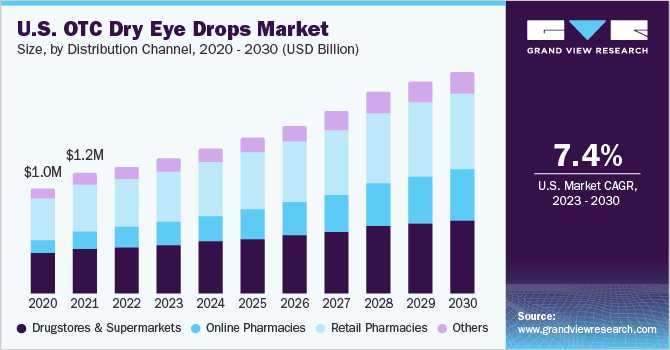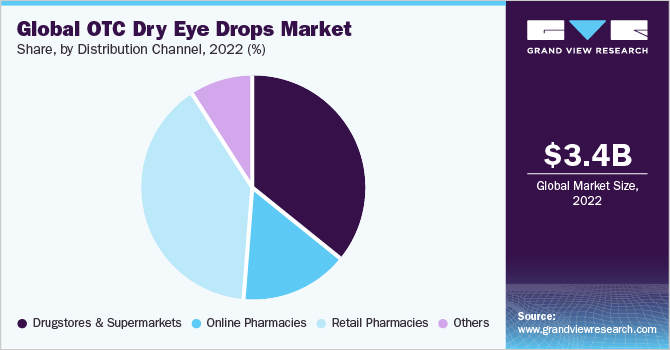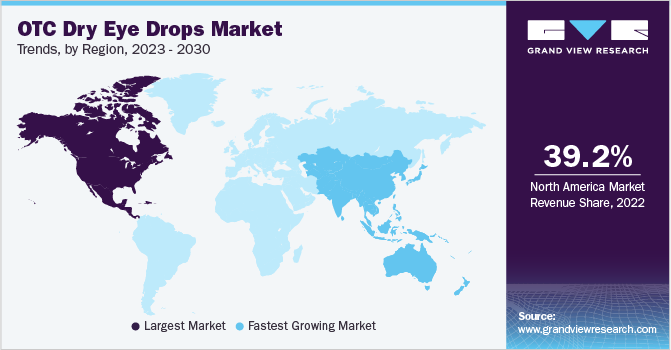- Home
- »
- Pharmaceuticals
- »
-
OTC Dry Eye Drops Market Size And Share Report, 2030GVR Report cover
![OTC Dry Eye Drops Market Size, Share & Trends Report]()
OTC Dry Eye Drops Market (2023 - 2030) Size, Share & Trends Analysis Report By Type (Branded, Generics), By Product Type (With Preservatives, Preservative Free), By Viscosity (Low, High), By Distribution Channel, By Region, And Segment Forecasts
- Report ID: GVR-4-68040-123-8
- Number of Report Pages: 130
- Format: PDF
- Historical Range: 2018 - 2021
- Forecast Period: 2023 - 2030
- Industry: Healthcare
- Report Summary
- Table of Contents
- Interactive Charts
- Methodology
- Download FREE Sample
-
Download Sample Report
Report Overview
The global OTC dry eye drops market size was estimated at USD 3.40 billion in 2022 and is expected to grow at a compound annual growth rate (CAGR) of 7.70% from 2023 to 2030. The market is witnessing growth due to factors such as the increasing prevalence of dry eye syndrome, changing lifestyles, rising awareness of eye health, and increasing cases of irreversible vision-threatening disorders. Moreover, the rising geriatric population is further expected to drive market growth. In 2021, research studies from the National Center for Biotechnology Information (NCBI) revealed that the prevalence of dry eye syndrome among the geriatric population was around 33%.

The high dry eye disease susceptibility in the aging population and the heightened use of digital devices, which can cause eyesight strain and dryness, are anticipated to improve product demand. Additionally, as per a report published in 2021 by BMC Ophthalmology, dry eye symptoms were found in 5-30% of older individuals, with the prevalence of dry eye being 8.4% among those younger than 60 years, 15% among individuals aged 70 to 79 years, and 20% among patients aged over 80 years.
The initial impact of COVID-19 on the dry eye market was negative due to cancellations of elective procedures, such as diagnosis and eye treatments, as well as global interruptions in the drug supply chain. Additionally, during the lockdown, people spent substantially more time on their screens, which had a negative influence; thus an upsurge in ocular problems was observed.This increase in screen time contributed to an increase in dry eye symptoms and a subsequent growth in demand for OTC eye drops.
The increasing use of contact lenses is another driving factor for the market. Contact lens-associated dry eye syndrome is recognized as a growing public health problem. According to an article published in Dove Medical Press, around 140 million individuals worldwide wear contact lenses, of which approximately 10-50% stop their usage within 3 years of commencement. One of the primary reasons reported is the sensation of dry eye among wearers. Around 40% of soft contact lens wearers reported a sensation of dry eye, and about 25% were suffering from moderate to severe symptoms, leading to decreased wearing times. All these factors are estimated to drive the market for OTC dry eye drops in the forecast period.
The relatively low cost of these drugs makes them very affordable for a large patient base, especially in low- and middle-income countries. They are commercially available and easily accessible. Some of the most commonly prescribed OTC products include Refresh Plus, Refresh Tears, Refresh Liquigel, GenTeal, Tears Naturale II, Tears Plus, HypoTears, Systane (thick), and Soothe.
Type Insights
The generics segment dominated the market and held the largest revenue share of 55.78% in 2022. The high share of this segment is primarily due to the cost-effectiveness of generic products. These are often more affordable than their brand-name counterparts, making generic products an easier alternative in markets where consumers are price-sensitive and looking for cost-effective options to manage their conditions. Additionally, ease of purchase further boosts segment growth, as generic products are readily available for purchase without a prescription, making them easily accessible to consumers.
The branded segment is anticipated to register a lucrative CAGR over the coming years. Branded products have an established reputation and recognition in the market; thereby, consumers have a higher level of trust and choose products from well-known and reputable brands owing to their history of quality and efficacy. Moreover, branded products have unique formulations and delivery methods protected by patents. This exclusivity can give these brands an edge in the market until generics can replicate or improve upon the patented features, thereby contributing to the overall growth.
Product Type Insights
The preservative segment dominated the market and held the largest revenue share of 60.06% in 2022.Dry eye drops with preservatives tend to have a longer shelf life compared to preservative-free alternatives. This longer shelf life can be attractive to both manufacturers and consumers, as it reduces the risk of product expiration and wastage. Furthermore, preservatives prevent bacterial growth in the solution, allowing the product to be stored at room temperature. This convenience in storage makes preservative-containing products more desirable to consumers, thereby contributing to overall growth.
On the other hand, the preservative-free segment is expected to witness the highest CAGR of 8.81% during the forecast period. Preservative-free eye drops are formulated without chemical preservatives, which is a significant advantage for individuals who are sensitive or allergic to preservatives. Moreover, growing awareness about the potential drawbacks of using preservatives in eye drops, such as dryness, discomfort, and allergic reactions, has been increasing. Thus, consumers are becoming more conscious of the ingredients in the products they use and are actively seeking preservative-free options.
Viscosity Insights
The low-viscosity segment dominated the market and held the largest revenue share of 74.00% in 2022. Ease of application and rapid relief are the major factors that drive segment growth. Low-viscosity eye drops are often easier to wear due to their thin and watery consistency. This makes them more comfortable to use, especially for individuals who may have difficulty with thicker or more viscous formulations. Moreover, low-viscosity eye drops tend to spread quickly across the ocular surface, providing rapid relief to dry and irritated eyes. Additionally, eye drops with low viscosity are better tolerated and easier to use than gel ocular drops or ointments.
On the other hand, the high-viscosity segment is expected to witness the fastest CAGR during the forecast period in the OTC dry eye drops market. High-viscosity eye drops can provide a longer duration of effect compared to low-viscosity eye drops; thus, the longer duration of effects is a major factor that boosts overall growth. Furthermore, high-viscosity eye drops are able to reduce friction, which can otherwise lead to inflammation, and minimize vision blurring, thus improving ocular comfort.
Distribution Channel Insights
The retail pharmacies segment dominated the market and held the largest revenue share of 39.60% in 2022. Accessibility and convenience play a crucial role in contributing to the segment growth. Retail pharmacies, including chain pharmacies and independent drugstores, are widespread and easily accessible to consumers. They are often conveniently located in neighborhoods, shopping centers, and healthcare facilities, making it easy for consumers to purchase OTC products like dry eye drops. Moreover, retail pharmacies offer one-stop shopping for a wide range of healthcare products, including OTC medications, supplements, personal care items, and more. This convenience encourages consumers to buy more products from retail pharmacies, thereby contributing to the growth of the segment.

The online pharmacies segment is expected to witness the highest CAGR of 13.38% during the forecast period. Online pharmacies save consumers’ time by eliminating the need to travel to a physical pharmacy. Thus, the time-saving factor is contributing to the segment’s growth. Moreover, the COVID-19 pandemic further accelerated the adoption of online pharmacies, as consumers sought ways to minimize physical interactions and reduce the risk of exposure to the virus.
Regional Insights
North America dominated the market with the largest revenue share of 39.17% in 2022 due to its large consumer base, advanced healthcare infrastructure, high awareness and education about health products, and a growing aging population with increased dry eye susceptibility. Moreover, the significant presence of pharmaceutical companies focusing on OTC products, higher disposable incomes, a supportive regulatory framework, and a strong retail pharmacy network further propel regional growth.
As per data from the National Health and Wellness Survey conducted in 2022, approximately 6.8% of the U.S. adult population has been diagnosed with dry eye disorder (DED). This has created a huge market opportunity for industry players, and manufacturers have responded by developing and promoting their products at a frequent pace.

The Asia Pacific region is estimated to witness the fastest growth in the market over the forecast period, aided by its large and burgeoning population base, an aging demographic leading to higher dry eye prevalence, and an ever-expanding middle class with increased purchasing power. The market in this region is highly price-sensitive and provides better growth opportunities for generic OTC dry eye drops.
Key Companies & Market Share Insights
Major market players are focused on adopting strategic initiatives such as launches, mergers & acquisitions, partnerships, etc. Furthermore, several players are focusing on the development of testing services, thereby boosting product demand. For instance, in July 2023, Bausch + Lomb acquired Blink OTC eye drops from Johnson & Johnson Vision for USD 106.5 million, with an aim to expand the company’s OTC product portfolio in the eye care market. Some of the key players in the global OTC dry eye drops market include:
-
Rohto Pharmaceutical Co. Ltd.
-
AbbVie, Inc.
-
Johnson & Johnson Services Inc.
-
Santen Pharmaceutical Co. Ltd.
-
Novartis AG
-
Prestige Consumer Healthcare Inc.
-
Altaire Pharmaceuticals Inc.
-
Sentiss Pharma Private Limited
-
Medicom Healthcare Ltd.
OTC Dry Eye Drops Market Report Scope
Report Attribute
Details
Market size value in 2023
USD 3.62 billion
Revenue forecast in 2030
USD 6.09 billion
Growth rate
CAGR of 7.70% from 2023 to 2030
Base year for estimation
2022
Historical data
2018 - 2021
Forecast period
2023 - 2030
Quantitative units
Revenue in USD billion/million and CAGR from 2023 to 2030
Report coverage
Revenue forecast, company ranking, competitive landscape, growth factors, and trends
Segments covered
Type, product type, viscosity, distribution channel, region
Regional scope
North America; Europe; Asia Pacific; Latin America; MEA
Country scope
U.S.; Canada; Germany; UK; France; Spain; Italy; Denmark; Norway; Sweden; Japan; China; India; Australia; South Korea; Thailand; Brazil; Mexico; Argentina; South Africa; Saudi Arabia; UAE; Kuwait
Key companies profiled
Rohto Pharmaceutical Co., Ltd.; AbbVie, Inc.; Johnson & Johnson Services Inc.; Santen Pharmaceutical Co. Ltd.; Novartis AG; Prestige Consumer Healthcare Inc.; Altaire Pharmaceutical Inc.; Sentiss Pharma Private Limited; Medicom Healthcare Pvt Ltd.
Customization scope
Free report customization (equivalent up to 8 analyst’s working days) with purchase. Addition or alteration to country, regional & segment scope.
Global OTC Dry Eye Drops Market Report Segmentation
This report forecasts revenue growth at the global, regional, and country levels and provides an analysis of the latest industry trends in each of the sub-segments from 2018 to 2030. For the purpose of this study, Grand View Research has segmented the global OTC dry eye drops market report on the basis of type, product type, viscosity, distribution channel, and region:
-
Type Outlook (Revenue, USD Million, 2018 - 2030)
-
Branded
-
Generics
-
-
Product Type Outlook (Revenue, USD Million, 2018 - 2030)
-
With Preservatives
-
Preservatives Free
-
-
Viscosity Outlook (Revenue, USD Million, 2018 - 2030)
-
Low Viscosity
-
High Viscosity
-
-
Distribution Channel Outlook (Revenue, USD Million, 2018 - 2030)
-
Drugstores and Supermarkets
-
Online Pharmacies
-
Retail Pharmacies
-
Others
-
-
Regional Outlook (Revenue, USD Million, 2018 - 2030)
-
North America
-
U.S.
-
Canada
-
-
Europe
-
Germany
-
UK
-
France
-
Italy
-
Spain
-
Denmark
-
Sweden
-
Norway
-
-
Asia Pacific
-
Japan
-
China
-
India
-
Australia
-
South Korea
-
Thailand
-
-
Latin America
-
Brazil
-
Mexico
-
Argentina
-
-
Middle East and Africa
-
South Africa
-
Saudi Arabia
-
UAE
-
Kuwait
-
-
Frequently Asked Questions About This Report
b. The global OTC dry eye drops market size was estimated at USD 3.40 billion in 2022 and is expected to reach USD 3.62 billion in 2023.
b. The global OTC dry eye drops market is expected to grow at a compound annual growth rate of 7.70% from 2023 to 2030 to reach USD 6.09 billion by 2030.
b. North America dominated the OTC dry eye drops market with a share of 39.17% in 2022. This is attributable to its large and diverse consumer base, advanced healthcare infrastructure, high awareness and education about health products, and a growing aging population with increased dry eye susceptibility are contributing the region's growth.
b. Some key players operating in the OTC dry eye drops market include Rohto Pharmaceutical Co., Ltd, AbbVie, Inc., Johnson & Johnson, Santen Pharmaceutical Co. Ltd, Novartis AG, Santen Pharmaceutical Co., Ltd., Prestige Consumer Healthcare Inc., Altaire Pharmaceutical Inc, Sentiss Pharma Private Limited, Medicom Healthcare Pvt Ltd.
b. Key factors that are driving the market growth include the increasing prevalence of dry eye syndrome, changing lifestyles, rising awareness of eye health as well as rising irreversible vision-threatening disorders. The high dry eye disease susceptibility in the aging population and the heightened use of digital devices, which can cause eyesight strain and dryness is anticipated to improve product demand.
Share this report with your colleague or friend.
Need a Tailored Report?
Customize this report to your needs — add regions, segments, or data points, with 20% free customization.

ISO 9001:2015 & 27001:2022 Certified
We are GDPR and CCPA compliant! Your transaction & personal information is safe and secure. For more details, please read our privacy policy.
Trusted market insights - try a free sample
See how our reports are structured and why industry leaders rely on Grand View Research. Get a free sample or ask us to tailor this report to your needs.










